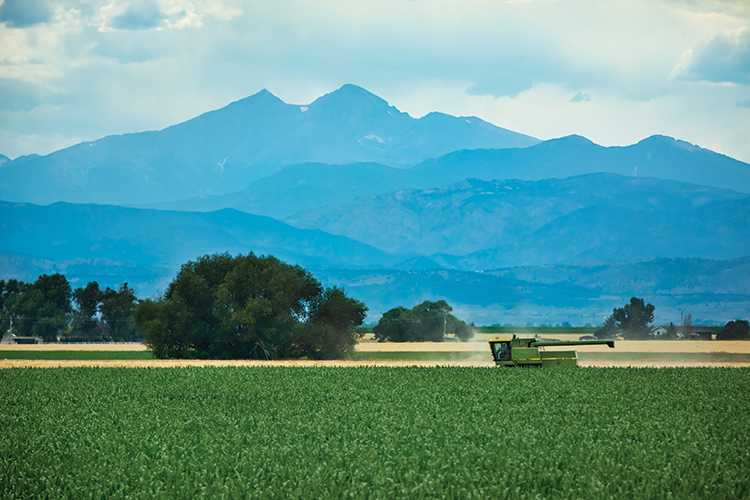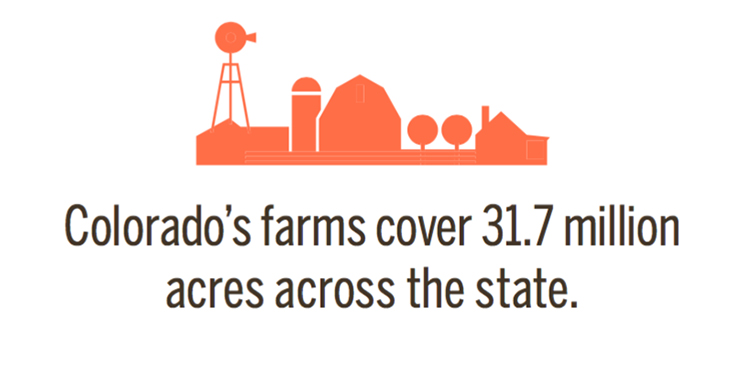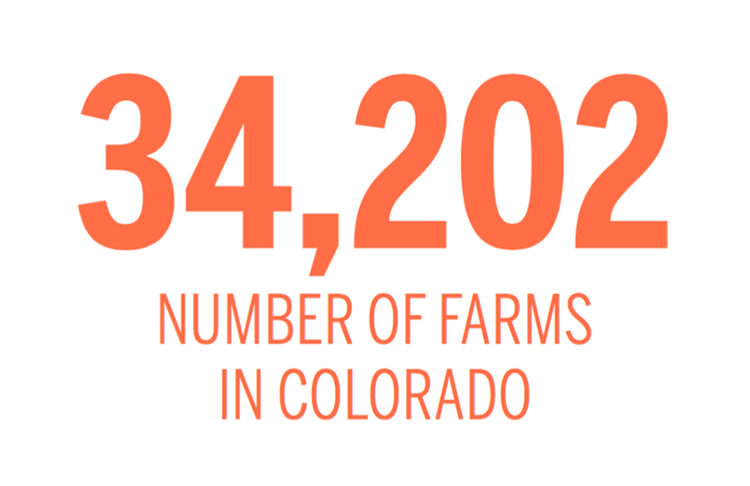Home > Colorado > Colorado Crops & Livestock > Colorado Grown
Colorado Grown
In partnership with: Colorado Department of Agriculture

In Colorado, the agriculture industry is as vast as the stunning mountains, stretching as far as the eye can see. Colorado agriculture is extremely important to the Centennial State’s economy, generating $41 billion of economic activity annually and employing nearly 173,000 Coloradans. The state’s 34,200 farms produce valuable crops and commodities on 31.7 million acres. The average farm size is 927 acres.
Colorado’s hardworking farmers and ranchers produce a wide variety of commodities for the state, country and world. In 2015, the state exported $1.8 billion in ag products, with top markets including Canada, Mexico, Japan, Korea and China.
Cattle and calves take the top spot for ag commodities, followed by dairy products, corn, hay, wheat, poultry and eggs, hogs, and potatoes. In fact, in 2015, cash receipts to Colorado’s ranchers from the sale of cattle and calves alone totaled $4 billion. But Colorado also ranks among the leading states for the production of fruits and vegetables like cabbage, cantaloupe, carrots, mushrooms, onions, peaches, potatoes and spinach. Colorado falls among the top 10 states in nearly 20 different agricultural products.
 More than just crops and commodities, Colorado agriculture encompasses local food, agricultural education, agribusiness, innovation and technology, forestry, and more.
More than just crops and commodities, Colorado agriculture encompasses local food, agricultural education, agribusiness, innovation and technology, forestry, and more.
The Centennial State is an innovative national leader, paving the way as the first in the nation to implement a certified industrial hemp seed program. Farmers are embracing innovation, driving efficiencies and maximizing sustainability with the use of global- positioning technology, drones, solar-powered sensors and more water-efficient irrigation systems.
But the state’s industry is rooted in tradition, too, celebrating “Centennial” farms and ranches that have been in the same family for at least a century and recognizing milestones, such as the 150th anniversary of the Colorado Cattlemen’s Association.
With a respect for tradition and an equal embrace of change, Colorado agriculture is only poised for more success.
 Better for You, Better for Colorado
Better for You, Better for Colorado
There’s no better way to support your state than buying local, and Colorado Proud makes it easy.
Managed by the Colorado Department of Agriculture, the Colorado Proud program identifies Colorado-grown, -raised or -processed products with a distinct logo, allowing consumers to make the easy choice of buying local products.
You make a difference when you buy local. Buying local contributes to the state’s economy by helping Colorado farmers, ranchers, growers, manufacturers and processors.
Find a listing of companies that participate in the program, as well as stores that carry local products, at coloradoproud.org.
 Sunny Side Up
Sunny Side Up
With impressive innovations and technological advancements, Colorado egg producers are breaking through the shell.
There are approximately 4.5 million hens in egg production in Colorado with cash receipts to egg producers topping $175 million in 2015.
But the most notable aspect of the industry is that Colorado egg production is almost 100 percent automated, ensuring fresh, safe and affordable eggs. Automatic grading machines allow up to 18,000 eggs to be inspected per hour, greatly improving efficiency.
This innovation benefits the hens as well, allowing them to live in a comfortable environment, and therefore, be more productive.
Learn more about Colorado eggs at Coloradoeggproducers.com.
 Fresh on the Menu
Fresh on the Menu
The farm-to-table movement is no longer a trend – it’s the norm.
Consumers more than ever want to know the exact farm or ranch that their food comes from, and Colorado restaurants are eager to deliver. The farm-to-table premise not only helps them give consumers what they want, but it also helps them form solid relationships with local farmers and ranchers, boosting Colorado’s economy and getting the freshest produce and meats available. Sourcing local helps restaurants cut down on travel time, and some chefs and restaurateurs even have their own farms, getting as local as possible.
 Water Works
Water Works
Though crop circles have been at the center of many alien-focused sci-fi and horror movies, the pretty patterns are actually a result of center-pivot irrigation, developed in Colorado in the late 1940s by Frank Zybach and Ernest Engelbrecht.
After the Ogallala Aquifer was discovered under the Great Plains, farmers were able to begin planting crops in areas that lacked sufficient rainfall necessary to yield bountiful crops. Zybach had a previous knowledge of sprinkler systems and developed the system, which uses equipment that rotates around a single central point, sprinkling water on the crops below.
The Engelbrecht Farm, located in Adams County, still features the original system and is part of the National Register of Historic Places.



